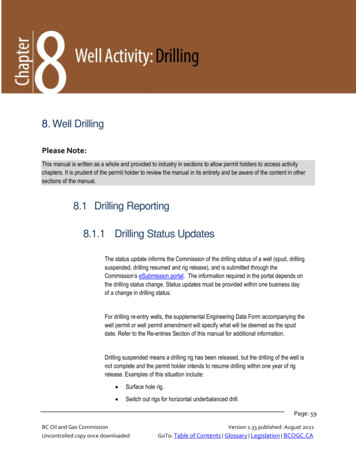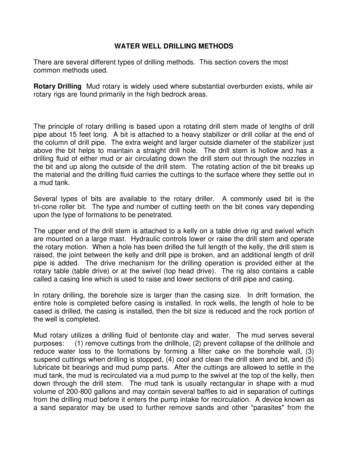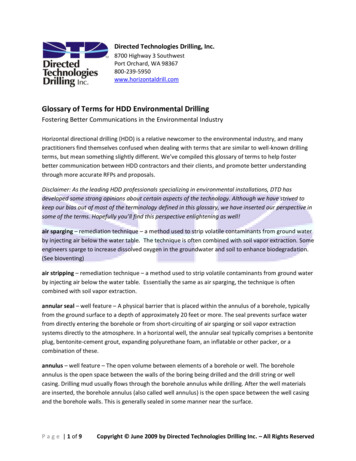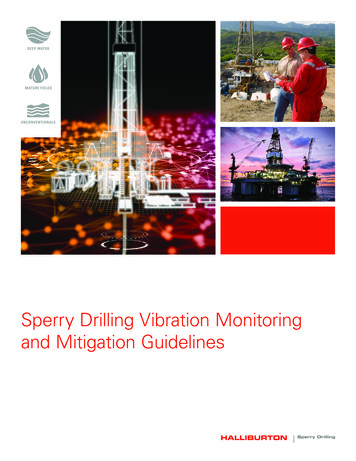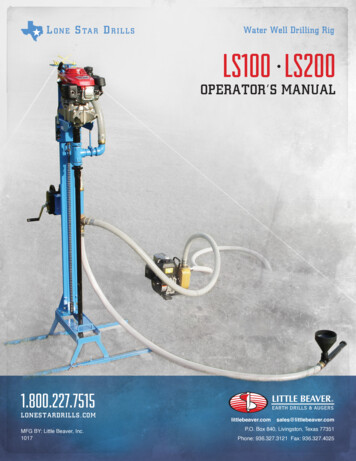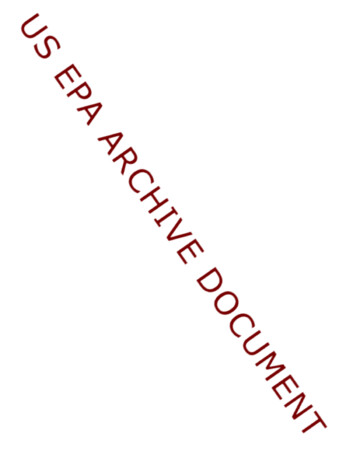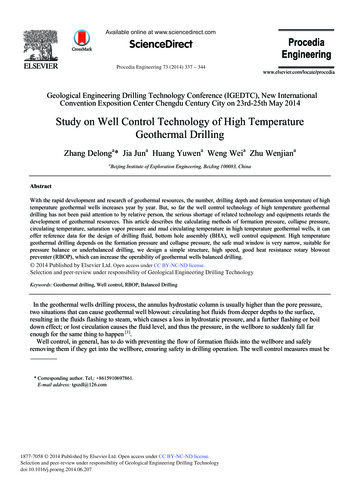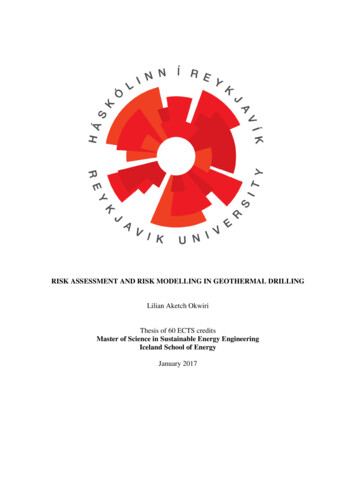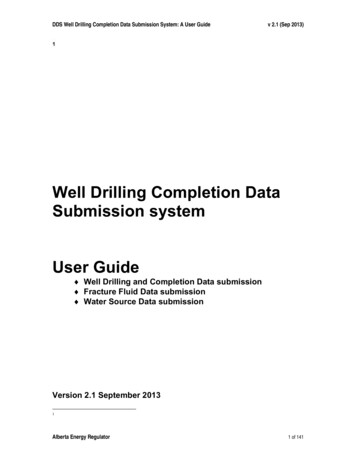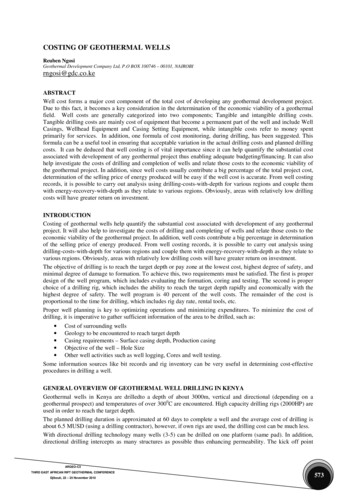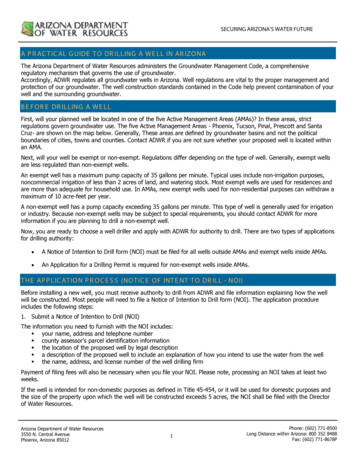
Transcription
SECURING ARIZONA’S WATER FUTUREA P R AC T IC AL G UIDE T O DR ILLING A WE LL IN AR IZONAThe Arizona Department of Water Resources administers the Groundwater Management Code, a comprehensiveregulatory mechanism that governs the use of groundwater.Accordingly, ADWR regulates all groundwater wells in Arizona. Well regulations are vital to the proper management andprotection of our groundwater. The well construction standards contained in the Code help prevent contamination of yourwell and the surrounding groundwater.B E F OR E DR ILLING A WE LLFirst, will your planned well be located in one of the five Active Management Areas (AMAs)? In these areas, strictregulations govern groundwater use. The five Active Management Areas - Phoenix, Tucson, Pinal, Prescott and SantaCruz- are shown on the map below. Generally, These areas are defined by groundwater basins and not the politicalboundaries of cities, towns and counties. Contact ADWR if you are not sure whether your proposed well is located withinan AMA.Next, will your well be exempt or non-exempt. Regulations differ depending on the type of well. Generally, exempt wellsare less regulated than non-exempt wells.An exempt well has a maximum pump capacity of 35 gallons per minute. Typical uses include non-irrigation purposes,noncommercial irrigation of less than 2 acres of land, and watering stock. Most exempt wells are used for residences andare more than adequate for household use. In AMAs, new exempt wells used for non-residential purposes can withdraw amaximum of 10 acre-feet per year.A non-exempt well has a pump capacity exceeding 35 gallons per minute. This type of well is generally used for irrigationor industry. Because non-exempt wells may be subject to special requirements, you should contact ADWR for moreinformation if you are planning to drill a non-exempt well.Now, you are ready to choose a well driller and apply with ADWR for authority to drill. There are two types of applicationsfor drilling authority: A Notice of Intention to Drill form (NOI) must be filed for all wells outside AMAs and exempt wells inside AMAs. An Application for a Drilling Permit is required for non-exempt wells inside AMAs.T HE AP P LIC AT ION P R OC E S S (NOT IC E OF INT E NT T O DR ILL - NOI)Before installing a new well, you must receive authority to drill from ADWR and file information explaining how the wellwill be constructed. Most people will need to file a Notice of Intention to Drill form (NOI). The application procedureincludes the following steps:1. Submit a Notice of Intention to Drill (NOI)The information you need to furnish with the NOI includes:your name, address and telephone numbercounty assessor’s parcel identification informationthe location of the proposed well by legal descriptiona description of the proposed well to include an explanation of how you intend to use the water from the wellthe name, address, and license number of the well drilling firmPayment of filing fees will also be necessary when you file your NOI. Please note, processing an NOI takes at least twoweeks.If the well is intended for non-domestic purposes as defined in Title 45-454, or it will be used for domestic purposes andthe size of the property upon which the well will be constructed exceeds 5 acres, the NOI shall be filed with the Directorof Water Resources.Arizona Department of Water Resources3550 N. Central AvenuePhoenix, Arizona 850121Phone: (602) 771-8500Long Distance within Arizona: 800 352 8488Fax: (602) 771-8678P
SECURING ARIZONA’S WATER FUTUREIf the well is intended for domestic purposes as defined in Title 45-454, and the size of the property upon which the wellwill be constructed is less than 5 acres, the NOI and site plan must be submitted to the county or local health authorityto ensure compliance with well siting and septic tank separation requirements. File the NOI in duplicate with a site plan.The site plan must:Include the county assessor’s parcel identification numberShow the proposed well location and location of any septic tank or sewer system that is either located on theproperty or within one hundred feet of the proposed well site.If the proposed well location meets State and local requirements, the health authority will then forward the NOI to ADWRfor review.If the health authority can not determine whether the proposed well location complies with State and local requirements,it makes a note on the site plan and on the NOI and forwards the copies of the NOI and site plan to ADWR for review.If the various factors prevent the well from being drilled in accordance with State and local requirements, the propertyowner may apply for a variance. You may request a variance from ADWR, or the county or local authorities, depending onthe steward of the legal element that prevents the well from being drilled.Filing a Notice of Intent automatically registers your well. Well registration benefits water users in the following ways:Well registration serves as evidence of your historical claim to use groundwater.Helps with notification if groundwater becomes contaminated in your area.ADWR can protect your well when granting permits for new wells in an AMA. (A concentration of wells can adverselyaffect well yields.)2. Receive Authorization to DrillADWR will give your well driller a drilling card authorizing the drilling of your well. This card must be in the well driller’spossession before drilling can begin and at all times during the actual work. The card lists the drilling firm, the licensenumber, and the location of the well. The drilling firm listed on the card must be the firm that constructs your well. Oncethe card has been issued, selecting another drilling firm will require that a change of driller request form be submitted toADWR, along with a filling fee.3. Complete the Well Driller’s ReportThe driller must complete a well driller’s report, including a well log. The well log contains information that will beimportant when doing work on your well in the future. The information required includes:the depth of the wellthe depth to the waterthe type and size of casing, andthe kind of material used in well construction.While the well is being constructed, you should check the driller’s records to make sure that the casing length, well depth,and well yield test results are reported accurately. (The well yield test determines the quantity of water your well canproduce.)4. File the Completion ReportYou must file a Completion Report within 30 days of equipping the well with a pump. There is not a time limit forcompleting pump installation but you cannot leave a drilled hole open. ADWR will mail the Completion Report forms toyou after you file a Notice of Intent. Your pump installer should be able to help you complete the report. The informationyou need for this report includes the type of pump installed, the pump capacity, and the results from the well yield test.LOC AT ING A WE LLAn important factor to consider when constructing a well is where to locate it. You will probably want to put your wellclose to where you will use the water and close to a power source. This will reduce your construction and energy costs.To protect the quality of your water, the state has adopted rules about well location. All wells must be at least 100 feetfrom septic tanks or sewage disposal areas. Check with your neighbors to make sure your proposed well is at least 100feet away from their septic systems. It is preferable to locate a well uphill from septic systems and as far away asArizona Department of Water Resources3550 N. Central AvenuePhoenix, Arizona 850122Phone: (602) 771-8500Long Distance within Arizona: 800 352 8488Fax: (602) 771-8678
SECURING ARIZONA’S WATER FUTUREpractical. Before drilling you should also check to see if your county health department has additional regulations affectingwell location.Here are three recommendations about locating your well:1. It is important to direct surface water drainage away from your well. If it is located on a hill, divert the up slopedrainage around or away from the well. It is preferable not to drill your well in an area that floods. If you must,take extra precautions to protect it, such as installing a pitless adaptor which allows you to pump and pipe waterunder the ground.2. You should leave enough room around your well for easy access during drilling, maintenance, repair and testing.3. It is preferable to locate your well as far away from neighboring wells as possible. Wells that are close togethercan interfere with each other, producing less water. You can contact ADWR’s Water Rights Records Section tofind the locations of other wells in your area.C HOOS ING MAT E R IALS AND E QUIP ME NTFactory-made equipment and materials should be used if you want a good quality well.A factory-made perforated casing or well screen is especially important, since a poorly made perforated casing or wellscreen may permit sand or mud to enter the well, or not permit enough water into the well for it to work properly.The pump is a very important component of the well system and should be selected carefully. The pump size should bebased on the well casing size and the quantity of water needed. If you choose a pump with a capacity greater than thewell yield, you may get muddy or sandy water or the well and pump may fail. When selecting a pump, choose a designthat will produce enough water yet will keep energy use to a minimum. Consult with your pump installer to select thebest equipment for your needs. When installing new pump equipment, be sure to obtain a copy of the warranty coveringthe pump.Many well owners opt for systems to store water pumped during times of low demand. A storage system will allow you tomeet your peak water demands if your pump capacity is not sufficient. A pump installer can help you plan a system thatincorporates water storage.S E LE C T ING A WE LL DR ILLE RYou may wish to talk with several drillers before selecting one. When talking with drillers, ask for the names of formercustomers in your area. Find out if they were satisfied with the driller’s work.You should also ask the driller questions about the work that will be completed and the payment of fees. Will you receivea written agreement or contract that spells out an understanding of the work to be done? Does the contract include allthe details and costs (including materials) of the well construction? A written contract can help avoid costlymisunderstandings.Make sure the driller you intend to hire is licensed. All well drillers must be licensed by both ADWR and the StateRegistrar of Contractors (ROC.) You can find out if a specific driller is licensed by contacting ADWR or the Registrar ofContractors. The category of license required by the ROC for residential or domestic water wells is a C-53.Before signing a contract with a well driller, you should read it carefully to make sure it includes:a cost estimate, including materials and labor chargesa target date for completing the welldetailed well specifications, such as diameter and depthspecific information about the surface sealthe driller’s plans for developing the wellthe method to be used for the yield testthe kinds of materials to be installed, such as the type and quality of casing; the drive shoe, if necessary; the typeand quality of well screen; the pump (if your driller is providing the pump); and all other pieces of equipmentprocedures and costs for abandoning or permanently closing the well if it cannot be usedArizona Department of Water Resources3550 N. Central AvenuePhoenix, Arizona 850123Phone: (602) 771-8500Long Distance within Arizona: 800 352 8488Fax: (602) 771-8678
SECURING ARIZONA’S WATER FUTUREC HE C K ING WE LL INS T ALLAT IONThere are four major steps involved in constructing a well:1. drilling the hole2. installing the casing3. well development; and4. pump installation or capping.You should monitor your driller’s work throughout construction. Make sure your well is equipped with a proper surfaceseal as required by Arizona’s well construction rules. A proper surface seal consists of a steel casing extending from onefoot above ground level to a depth of 20 feet surrounded by cement grout. The grout is used to seal the casing socontaminants cannot enter the well from the surface. The state has established a minimum standard of 1.5 inches ofcement grout poured in the space between the borehole wall and the casing in one continuous application from aminimum depth of 20 feet to the land surface.Make sure your driller properly develops and disinfects your well. Well development involves removing the drill cuttingsand drilling materials from the well to make the water suitable for use. A well that has been properly drilled anddeveloped should produce water free of sand and mud. To disinfect a well, chlorine must be added. Various methods canbe used to do this. However, with any procedure the concentration of chlorine in the well should be at least 50 milligramsper liter. This work should be performed by your licensed driller.Once drilling is completed and the rig is moved off the site, your well must be protected by covering the drill hole toprevent contaminants from entering the well and to help prevent water waste. This requires either installing a pump orsealing the well with a watertight cap. Upon completion of drilling and removal of the drilling rig, the well must be in oneof the following conditions:equipped with a pumpcapped, orabandonedCapping will not prevent you from using your well later. Abandoning your well means to take it out of servicepermanently. Usually, a well is abandoned because it does not produce sufficient amounts of water or it produces poorquality water. Procedures for abandonment are discussed later.K E E P ING Y OUR WE LL S AF EAfter well construction is completed and the surface seal is in place, a few simple steps will help keep your well in safeoperating condition. Before you use your well for drinking water, you should have the water analyzed for bacteriologicaland chemical qualities. Independent laboratories can perform these tests. It is also good to have your water analyzed forbacteriological quality each year and for chemical quality every three years. Changes in water quality could indicatedefects in the well system.Protecting the quality of your water is extremely important. Do not store poisons, pesticides, or other hazardous materialsin your pump house or near your well. An accidental spill could contaminate the well and the aquifer. Never use your wellas a place to dispose of anything. You should keep records of all work done on your well. If you lose your well records,ADWR’s Water Rights Record Section can give you copies of the documents that have been filed on your well.AB ANDONING A WE LLWhen it becomes necessary to abandon a well, you must follow ADWR rules regarding well abandonment. Wellabandonment shall be performed only by a licensed well drilling contractor or a property owner who has obtained a singlewell license from ADWR. The owner of a well shall file a Notice of Intention to Abandon a Well form (NOIA) prior toArizona Department of Water Resources3550 N. Central AvenuePhoenix, Arizona 850124Phone: (602) 771-8500Long Distance within Arizona: 800 352 8488Fax: (602) 771-8678
SECURING ARIZONA’S WATER FUTUREabandonment, on a form prescribed and furnished by the Director. Upon receipt of a proper NOIA, the Director shall maila well abandonment card to the designated well drilling contractor or single well licensee. Only at that time may the welldrilling contractor or single well licensee commence abandonment of a well.The abandonment of the well shall be accomplished through filling or sealing the well so as to prevent the well, includingthe annular space outside the casing, from being a channel allowing the vertical movement of water. The well shall befilled from the bottom to a depth of 20 feet with cement grout, concrete, bentonite, clean sand with bentonite or cuttingsfrom the well. A cement grout plug shall be set from the top of the well to minimum of 20 feet below the land surfaceand the annular space outside the casing (if applicable) shall be filled with cement from the land surface to a minimum of20 feet below the surface. Materials containing organic or toxic matter shall not be used in the abandonment of a well.The well drilling contractor or single well licensee shall notify ADWR in writing no later than 30 days after abandonmenthas been completed. The notification shall include the well owner’s name, the location of the well, and the method ofabandonment.F R E QUE NT LY AS K E D QUE S T IONSHere are some frequently asked questions about wells. If you have additional questions, contact ADWR for moreinformation.Q: May I have two wells at my house?A: Under some circumstances. If you are outside an AMA, there are no restrictions on the number of wells you mayconstruct as long as the water is put to reasonable and beneficial use. Contact ADWR if you are unsure whether your wellis located outside an AMA.Within the AMA, you cannot have two exempt wells serving the same purpose at the same location. You may use twoexempt wells for different purposes.If you wish to drill additional non-exempt wells within an AMA, contact ADWR to find out what restrictions apply.Q: How much should a well cost?A: The cost of a well depends on its size, depth, and location. It is good to compare estimates from several drillers to besure you are getting the best value for your money. Remember, the lowest price may not be the best deal.Q: How do I find a qualified well driller?A: ADWR cannot recommend a specific well driller. However, ADWR and the Registrar of Contractors can tell you if adriller is licensed and in good standing.C ONT AC T SArizona Department of Water Resources3550 N. Central AvenuePhoenix, AZ 850012 (602) 771-8500Groundwater Management Support Section: (602) 771-8535Primary point of contact for questions pertaining to the filing of Notice of Intention to Drill (NOI) forms, wellconstruction and the licensing of well drillersWater Rights Records Section: (602) 771-8649Phoenix AMA3550 N. Central AvenuePhoenix, Arizona 85012(602) 771-8585Arizona Department of Water Resources3550 N. Central AvenuePhoenix, Arizona 850125Phone: (602) 771-8500Long Distance within Arizona: 800 352 8488Fax: (602) 771-8678
SECURING ARIZONA’S WATER FUTURETucson AMA400 West Congress, Suite 518Tucson, AZ 85701-1374(520) 770-3800Pinal AMA1729 N. Trekell Road Suite 105Casa Grande, AZ 85222(520) 836-4857Prescott AMA2200 East Hillsdale RoadPrescott, AZ 86301-4941(928) 778-7202Santa Cruz AMA857 West Bell Road, Suite 3Nogales, AZ 85621-4545(520) 761-1814Arizona Department of Water Resources3550 N. Central AvenuePhoenix, Arizona 850126Phone: (602) 771-8500Long Distance within Arizona: 800 352 8488Fax: (602) 771-8678
ADWR will give your well driller a drilling card authorizing the drilling of your well. This card must be in the well driller's possession before drilling can begin and at all times during the actual work. The card lists the drilling firm, the license number, and the location of the well.
